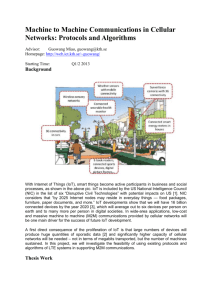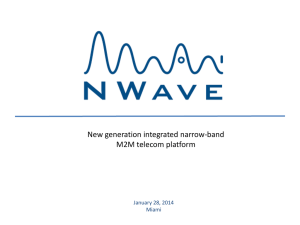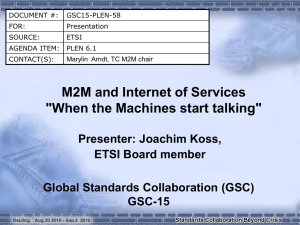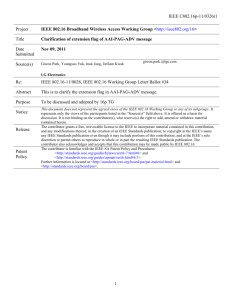C80216ppc-10_0009
advertisement
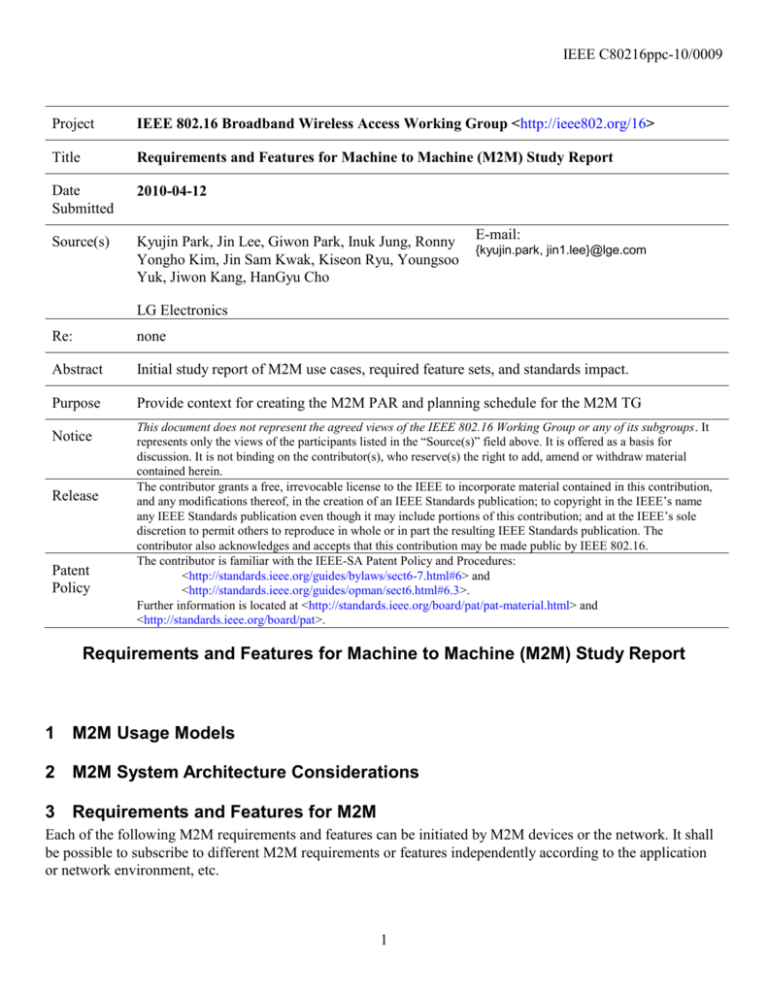
IEEE C80216ppc-10/0009
Project
IEEE 802.16 Broadband Wireless Access Working Group <http://ieee802.org/16>
Title
Requirements and Features for Machine to Machine (M2M) Study Report
Date
Submitted
2010-04-12
Source(s)
Kyujin Park, Jin Lee, Giwon Park, Inuk Jung, Ronny
Yongho Kim, Jin Sam Kwak, Kiseon Ryu, Youngsoo
Yuk, Jiwon Kang, HanGyu Cho
E-mail:
{kyujin.park, jin1.lee}@lge.com
LG Electronics
Re:
none
Abstract
Initial study report of M2M use cases, required feature sets, and standards impact.
Purpose
Provide context for creating the M2M PAR and planning schedule for the M2M TG
Notice
Release
Patent
Policy
This document does not represent the agreed views of the IEEE 802.16 Working Group or any of its subgroups. It
represents only the views of the participants listed in the “Source(s)” field above. It is offered as a basis for
discussion. It is not binding on the contributor(s), who reserve(s) the right to add, amend or withdraw material
contained herein.
The contributor grants a free, irrevocable license to the IEEE to incorporate material contained in this contribution,
and any modifications thereof, in the creation of an IEEE Standards publication; to copyright in the IEEE’s name
any IEEE Standards publication even though it may include portions of this contribution; and at the IEEE’s sole
discretion to permit others to reproduce in whole or in part the resulting IEEE Standards publication. The
contributor also acknowledges and accepts that this contribution may be made public by IEEE 802.16.
The contributor is familiar with the IEEE-SA Patent Policy and Procedures:
<http://standards.ieee.org/guides/bylaws/sect6-7.html#6> and
<http://standards.ieee.org/guides/opman/sect6.html#6.3>.
Further information is located at <http://standards.ieee.org/board/pat/pat-material.html> and
<http://standards.ieee.org/board/pat>.
Requirements and Features for Machine to Machine (M2M) Study Report
1 M2M Usage Models
2 M2M System Architecture Considerations
3 Requirements and Features for M2M
Each of the following M2M requirements and features can be initiated by M2M devices or the network. It shall
be possible to subscribe to different M2M requirements or features independently according to the application
or network environment, etc.
1
IEEE C80216ppc-10/0009
3.1 Extremely Low Power Consumption
IEEE 802.16p system shall support extra low power consumption for battery limited M2M devices. The system
shall be able to provide enhanced power saving mechanisms for extra low power consumption. M2M devices
for tracking & tracing, health care and public safety can be the applications requiring extremely low power
consumption.
3.2 High Reliability
IEEE 802.16p system shall be able to guarantee connection and reliable transmission between a M2M device
and the M2M server for specific applications regardless of operating environment (e.g. mobility, channel
quality). Healthcare M2M services and emergency related services can be the applications requiring high
reliability.
3.3 Enhanced Access Priority
IEEE 802.16p system shall support prioritized network access for specific M2M devices. IEEE 802.16p M2M
devices should be able to transmit a message indicating emergency at any states (connected or idle). The
applications where access priority is required can be healthcare, public safety and tracking & tracing (e.g.
emergency call situations).
3.4 Active QoS
3.5 Mass Device Transmission
IEEE 802.16p system shall support data transmission of a large number of M2M devices simultaneously. IEEE
802.16p system shall support grouping of M2M devices belonging to the same subscriber or M2M application.
The system shall be able to identify a group of M2M devices and an individual M2M device in a group. The
system shall be able to provide group-based handling of M2M devices.
3.6 Device Collaboration
3.7 Security
IEEE 802.16p system shall not degrade security compared to non M2M communications. The system shall
support the integrity protection and the confidentiality for M2M service traffic, and M2M device authentication
to provide the secure access to the authorized M2M devices.
3.8 No Mobility
IEEE 802.16p system shall be able to simplify and optimize the mobility-related operations for M2M devices
with fixed location. Smart metering, secured access and remote control & maintenance can be the usage models
where no mobility feature is required.
3.9 Small Data Transmission
IEEE 802.16p system shall provide a mechanism to transmit or receive small data bursts with low overhead.
The M2M applications can be smart metering and tracking & tracing services.
2
IEEE C80216ppc-10/0009
3.10 Time-Controlled
IEEE 802.16p system shall be able to provide time-controlled operation of M2M devices where the M2M
devices transmit or receive data during a pre-defined time period. The smart metering, tracking & tracing,
secured access and public safety can be the applications where time controlled M2M feature is required.
3.11 Device-Originated Only
IEEE 802.16p system shall support M2M services where data traffic is generated only by M2M devices. Public
safety can be the application for device originated feature.
3.12 Device-Terminated Only
IEEE 802.16p system shall support M2M services where data traffic is generated only by M2M servers. Digital
signage and consumer devices can be the applications where device terminated feature is required.
3.13 Time-Tolerant
IEEE 802.16p system shall utilize time-tolerant feature for M2M devices. The system shall be able to defer the
data transmission of the time tolerant M2M devices. The application of time tolerant M2M feature can be
metering.
3.14 Extremely Low Latency
IEEE 802.16p system shall provide reduced network access latency and/or data transmission latency for specific
M2M devices. The healthcare services and emergency-related services can be the application where extremely
low latency is required.
3.15 Enhanced LBS
4 IEEE 802.16p system shall be able to provide enhanced location positioning
of M2M devices. Tracking & tracing can be the application for accurate
location M2M feature.802.16 Standards Impact
4.1
MAC Layer Changes needed
4.2
Physical Layer Changes needed
5 Recommendations
3





